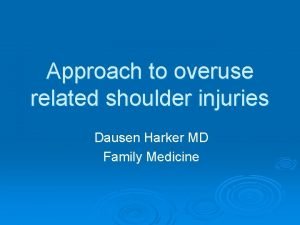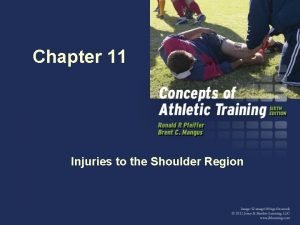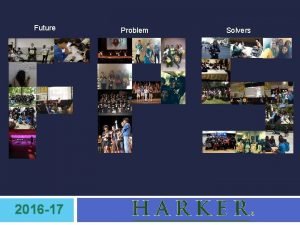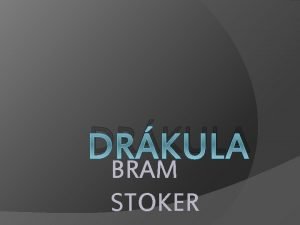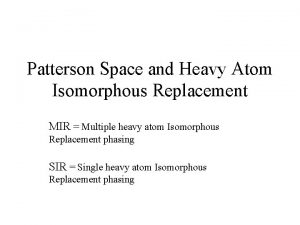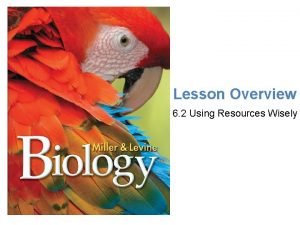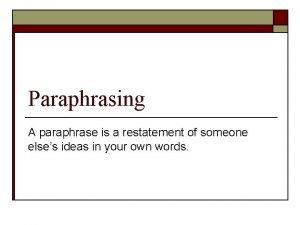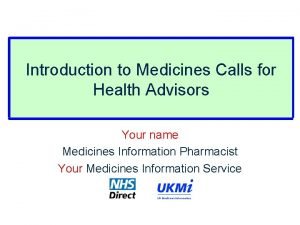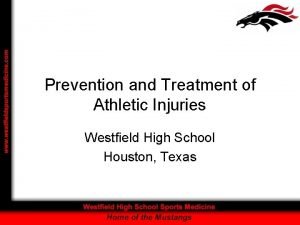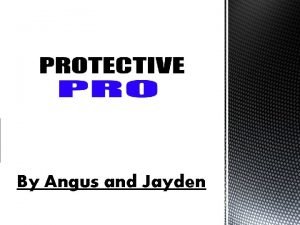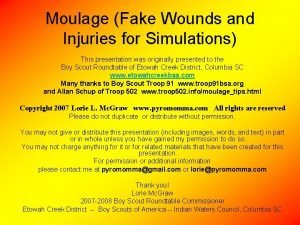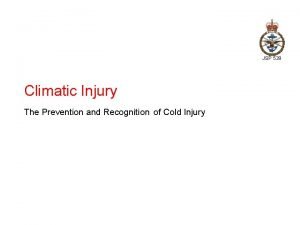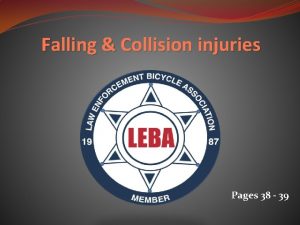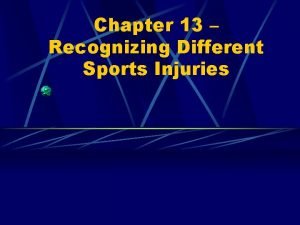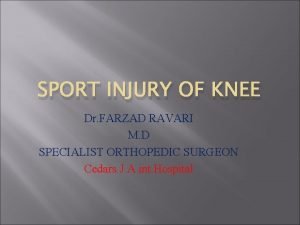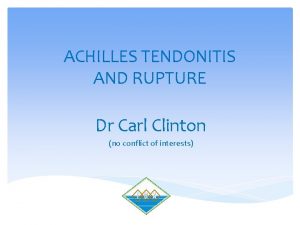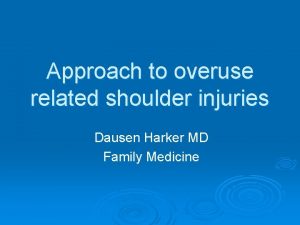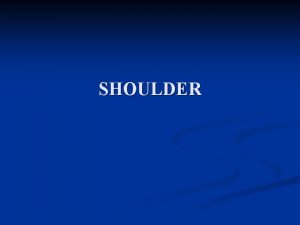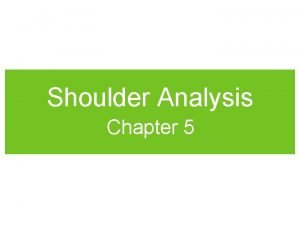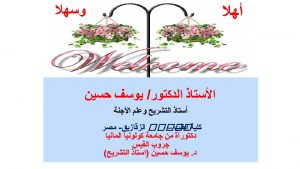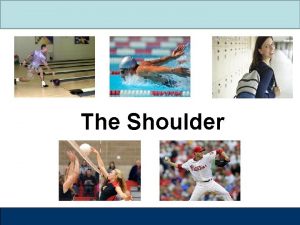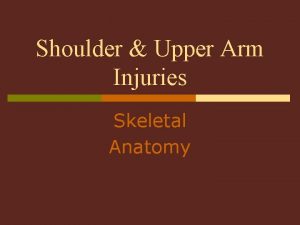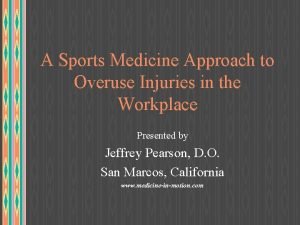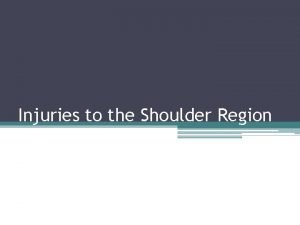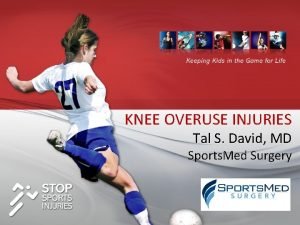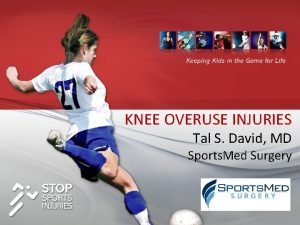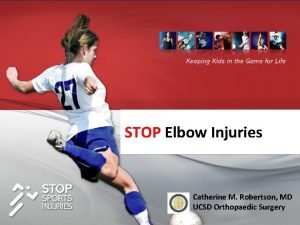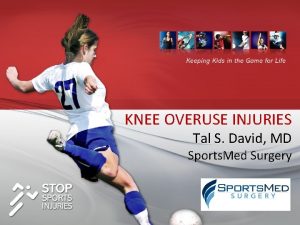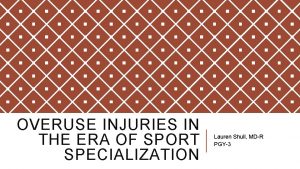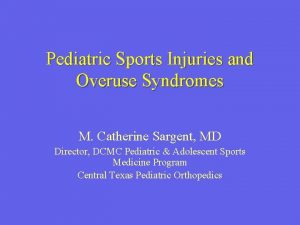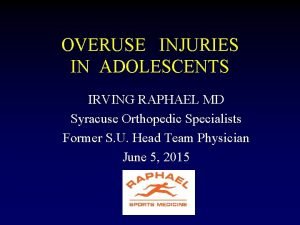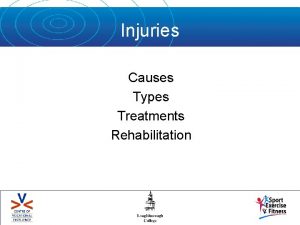Approach to overuse related shoulder injuries Dausen Harker

































- Slides: 33

Approach to overuse related shoulder injuries Dausen Harker MD Family Medicine

Objectives Ø Epidemiology Review Ø Shoulder anatomy review Ø Common causes of shoulder pain Ø General approach to exam Ø Special tests

Epidemiology Ø Ø 2 nd most common orthopedic problem in primary care sports medicine (second to knee injury) Young athletes with overuse injuries is increasing Overuse injuries common in military population Most common overuse injuries l l l Rotator Cuff Pathology Impingement Glenohumeral Instability/Labrum Tears Biceps Tendonitis AC Joint Pathology

Anatomical structures Please review images of shoulder anatomy prior to or while viewing slides Ø Major anatomical components involved in shoulder pain Ø l l l Rotator cuff muscles and tendons AC joint Glenoid and labrum Biceps tendon Skeletal components of shoulder Shoulder related bursa

Evaluation Ø Every shoulder exam should include: l l Appearance Range of Motion • Active vs Passive l l l Palpation Neurological testing Special tests

Rotator Cuff Injury Ø One of the most common causes of shoulder pain Ø Involves “SITS minor” muscles Ø Includes tendonitis and tears

Rotator Cuff Injury l Tendonitis: • Most common condition among pt’s with shoulder complaints—especially >30 y/o • Supraspinatous or infraspinatous • Repetitive over head activity most common cause • Pain l l Worse with reaching and over head activity May awaken pt at night • Associated with increased risk of tear

Rotator Cuff Injury l Tears: • • <30 y/o: <1% of shoulder injury are complete tears >45 y/o: ~35% of shoulder injury are tears Supraspinatous and Infraspinatous Common mechanisms of injury l l l Fall on an outstretched arm direct blow to shoulder rapid acceleration • Associated with chronic impingement, tendon degeneration or trauma • Clinical signs: Weakness, loss of shoulder function, and symptoms of tendonitis

Special Tests Ø Drop Arm Test Ø Supraspinatous Strength Test Ø Lift Off Test Ø 900 elbow flexion with external arm rotation and resistance

Drop Arm Test Ø Slowly lower fully ABducted arm Ø Active pressure may be applied at 900 ABduction Ø Positive test indicated by inability to keep arm ABducted at 900 Ø Indicates rotator cuff tear

Supraspinatous Strength Test Shoulder ABducted to 900 with 300 of forward flexion and arm pronation (thumb down) Ø Isolates supraspinatous Ø Positive test if asymmetric weakness or inability to maintain arm position Ø

Lift Off Test Dorsum of hand on back and push outward against resistance (isolates internal rotation) Ø Isolates subscapularis Ø Positive test indicated by asymmetric inability to lift hand from back Ø

External Rotation Ø Elbow flexed to 900 with active resistance to external rotation Ø Isolates infraspinatous and teres minor Ø Positive test indicated by asymmetric weakness

Impingement Ø Describes compression of rotator cuff tendons and subacromial bursa between bony structures Ø Mechanisms of injury: Rounded shoulders, poor muscle development, repetitive over head motion Ø Presentation nearly identical to rotator cuff injury

Special Tests Ø Hawkins Test Ø Neers Test

Special Tests Ø Hawkins Test l l 900 forward flexion, 45 -900 elbow flexion and passive internal rotation Drives greater tuberosity into coracoacromial arch Positive test indicated by pain More sensitive than Neers test for impingement

Special Tests Ø Neer Test l l Arm internally rotated while fully extended and forward flexion to 1800 Positive test indicated by pain with motion

Glenohumeral Instability/Labral tears Ø GHI l l Characteristic group: Women, poor muscular development, large Rotator cuff tears, athletes < 40 (especially swimmers, throwers) Clinical presentation: Vague symptoms, may see excessive ROM TUBS: Traumatic, Unidirectional instability, Bankart lesion (glenoid labrum tear), frequently require Surgery AMBRI: Atraumatic, Multidirectional shoulder laxity Bilaterally, usually responds to Rehabilitation, when sugery is necessary it involves tightening of Inferior capsule

Glenohumeral Instability/Labral Tears Ø LT l l l Caused by similar mechanism as rotator cuff injuries Greatest risk with repetitive overhead activities Clinical presentation: Deep shoulder pain, catching sensation, instability

Special Tests Ø GHI l l l Sulcus Sign Apprehension Test Anterior/Posterior Drawer Test Ø LT l Crank Test

Special Tests Ø Sulcus Sign l l Arm relaxed, neutral position with downward traction at wrist Positive indicated by development of sulcus Important to assess symmetry of test Sulcus sign recorded as cm of sulcus

Special Tests Ø Apprehension Test l l l Supine position, 900 ABduction, neutral rotation Apply slight leverage at proximal humerus while externally rotating Positive test indicated by pt apprehension that shoulder will give way

Special Tests Ø Anterior/Posterior Drawer Test l l l Best to have patient in supine position Humeral head slid anteriorly and posteriorly in glenoid while scapula is stabilized Positive test with painful click/clunk, apprehension or increased movement compared to other shoulder

Special Tests Ø Crank Test l l Pt supine or seated with arm elevated to 1600 Force applied along axis with internal and external rotation Drives humeral head against labrum Positive test if pain is reproduced or catching +/- click is noted

Biceps Tendonitis Ø Inflammation of long head of biceps as it passes through bicipital groove Ø Assoc with repetitive lifting or overhead activity that leads to inflammation Ø Can lead to spontaneous rupture (10%) Ø Pain aggravated by lifting, carrying bags or overhead reaching; Ø pt often localizes pain directly to bicipital groove

Special Tests Ø Speed Test Ø Yergason Test

Special Tests Ø Speed Test l l l Shoulder forward flexed to 600, arm flexed to 300 and supinated Downward force applied to distal forearm Positive test indicated by pain or weakness

Special Tests Ø Yergason Test l l l Arm neutral, elbow flexed to 900 Pt attempts to supinate and flex elbow against resistance Positive test indicated pain or a “painful pop”

AC Joint Pathology Ø Injury type: Sprain, partial or complete tear Ø Associated with overuse (reaching across chest or overhead) or trauma (especially falls on tip of shoulder) Ø Associated with anterior shoulder pain Ø Pt usually localize pain directly to AC joint (i. e. pt will point to AC joint)

Special Tests Ø Cross Chest ADduction Test (Cross Arm Test) l l Forward flexed to 900 and hand to opposite shoulder Examiner hyper. ADducts shoulder Positive test indicated by pain at AC joint May be false + with impingement

Summary Shoulder injury common in primary care sports medicine Ø Difficult exam due to complexity of shoulder Ø l Ø Made easier by following step wise approach The Big 5’s l l Overuse Injuries: Rotator cuff pathology, Impingement, GHI/LT, Biceps tendonitis, AC joint pathology Physical Exam: Appearance, ROM, Palpation, Neurologic, Special Tests

Summary Special Tests Ø Rotator Cuff l l Ø Drop Arm Test Supraspinatous Strength Test Lift Off Test External Rotation Impingement l l Hawkins Test Neer’s Test Ø GHI l l l Ø LT l Ø Crank Test Biceps Tendonitis l l Ø Sulcus Sign Apprehension Test Anterior/Posterior Drawer Test Speed Test Yergason Test AC Joint l Cross Arm Test

Resources Anderson, Bruce. “Acromioclavicular Injury. ” Up. To. Date®. www. uptodate. com. © 2006. Howard, Anderson, Bruce. “Biceps Tendonitis and Rupture. ” Up. To. Date®. www. uptodate. com. © 2006. Anderson, Bruce. “Multidirectional Instability of the Shoulder. ” Up. To. Date®. www. uptodate. com. © 2006. Anderson, Bruce. “Rotator Cuff Tendonitis. ” Up. To. Date®. www. uptodate. com. © 2006 Anderson, Bruce and Michael Roberts. “Shoulder Impingement Syndrome. ” Up. To. Date®. www. uptodate. com. © 2006. Anderson, Bruce and Ronald Anderson. “Evaluation of the Patient with Shoulder Complaints. ” Up. To. Date®. www. uptodate. com. © 2006. Anderson, Bruce, et. al. “Rotator Cuff Tear. ” Up. To. Date®. www. uptodate. com. © 2006. Cassas, Kyle J. and Amelia Cassettari-Wayhs. “Childhood and Adolescent Sports-Related Overuse Injuries. ” American Family Physician. March 2006. Vol 73, No. 6. pp 1014 -1022. Thomas M. , Francis G. O’Conner. “The Injured Shoulder. Primary Care Assessment. ” Archives of Family Medicine July/August 1997, Vol. 6. pp 376 -384
 Dausen harker
Dausen harker Chapter 11 injuries to the shoulder region
Chapter 11 injuries to the shoulder region Harker heights vet center
Harker heights vet center Harker
Harker Josh reinert
Josh reinert Saloni shah harker
Saloni shah harker Mina harker
Mina harker Harker
Harker Using resources wisely is called
Using resources wisely is called Restating or paraphrasing
Restating or paraphrasing Olbas inhaler overuse
Olbas inhaler overuse 2 types of fitness
2 types of fitness Health-related skill
Health-related skill What is research approach
What is research approach Fine-grained screening
Fine-grained screening Cognitive approach vs behavioral approach
Cognitive approach vs behavioral approach Traditional approach in system analysis and design
Traditional approach in system analysis and design Multiple approach avoidance
Multiple approach avoidance Tony wagner's seven survival skills
Tony wagner's seven survival skills Bandura's reciprocal determinism
Bandura's reciprocal determinism Datagram approach
Datagram approach Westfield sports injuries
Westfield sports injuries Sports injuries angus, on
Sports injuries angus, on How to make fake skin with gelatin
How to make fake skin with gelatin Climatic injuries
Climatic injuries Chapter 14:1 using body mechanics
Chapter 14:1 using body mechanics Chapter 21 caring for head and spine injuries
Chapter 21 caring for head and spine injuries Hunger games chapter 3 questions
Hunger games chapter 3 questions Unit 15:10 providing first aid for specific injuries
Unit 15:10 providing first aid for specific injuries Injuries first aid
Injuries first aid Chapter 13 worksheet recognizing different sports injuries
Chapter 13 worksheet recognizing different sports injuries Miniscal cyst
Miniscal cyst Clinton achilles tendonitis
Clinton achilles tendonitis Tnt swimming
Tnt swimming
